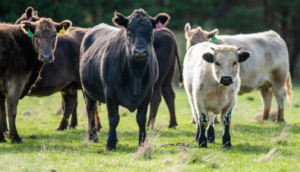Read the latest information on
Foot-and-mouth disease

Bronwyn Hendry, Head of Program Animal Health, Surveillance and Monitoring at Animal Health Australia sat down with us to talk about Lumpy Skin Disease (LSD): what it is, what to
look out for, and how to protect your farm.
Q: What is Lumpy Skin Disease (LSD)?
A: Lumpy skin disease is a highly infectious viral disease that affects all breeds of cattle and water buffalo. It does not affect other types of livestock or humans. Animals infected with the disease present with fever, depression, and characteristic skin nodules.
Q: How is it spread?
A: Lumpy skin disease is mostly spread by biting insects such as mosquitoes, biting flies and possibly ticks. It can also be spread through direct contact between animals and by contaminated feed, water, vehicles, and other things such as repeated use of needles on different animals.
Q: Australia is currently free of LSD, why should producers be concerned?
A: Once in a herd, the disease is very difficult to eradicate and there are no specific treatments available for affected animals. Australia is now on high alert for lumpy skin disease as the disease has been expanding rapidly through China and Southeast Asia since 2019. In 2021 the disease was confirmed in Vietnam, Thailand and Malaysia. In March 2022 it was officially reported by Indonesia on the island of Sumatra.
Q: What impact could an outbreak have?
A: The morbidity and mortality rates for lumpy skin disease in cattle vary greatly in different parts of the world where the disease occurs. An outbreak in a previously free country such as Australia could be expected to result in a high morbidity rate. If lumpy skin disease became endemic, continuing economic loss would occur due to stock losses, reduced production in the cattle industries and the cost of preventative vaccination (once it becomes available). Loss of many export markets would also be expected, with associated downturn in the rural economy and increased rural unemployment.

Q: What signs and symptoms should producers be monitoring for?
A: Producers should keep an eye out for the following clinical signs in their cattle:
Cattle may rapidly lose body condition, and some may need to be euthanased. Those that recover may remain in extremely poor condition for some time. Morbidity rates vary greatly and typically range between 10–20 per cent. A mortality rate of 1–5 per cent is usual.
Q: What precautions should producers in Australia be taking right now?
A: Control of mosquitoes, other biting insects and possibly ticks is important practice in parts of the world where lumpy skin disease occurs.
Remember that chemical residues can pose a risk to food quality and trade. The product label must always be followed when using chemicals and professional advice sought if required. Records should be kept of the chemicals used to control mosquitoes, biting flies and ticks.
Effective insect management may include measures such as:
Q: What should producers do if they suspect an animal has LSD?
A: Producers have an important role to play in the early detection of lumpy skin disease, should an incursion into Australia occur. Early detection of the disease, before it becomes widespread, increases the likelihood of successful containment and eradication.
You should immediately report any unusual signs of illness in animals to the Emergency Animal Disease Hotline on 1800 675 888, your veterinarian, or your state/territory department of primary industries (or equivalent).
Q: What arrangements are in place to manage this disease if an outbreak occurs in Australia?
A: Australia has arrangements in place to manage animal disease outbreaks. The AUSVETPLAN lumpy skin disease response strategy (which is currently being updated) describes the nationally agreed approach to control and eradicate lumpy skin disease if it occurs in Australia. The Emergency Animal Disease Response Agreement (or EADRA) is an agreement between all state and territory governments, the Australian government and livestock industry bodies which enables a quick and effective response to an EAD incident, while minimising uncertainty over management and funding arrangements.